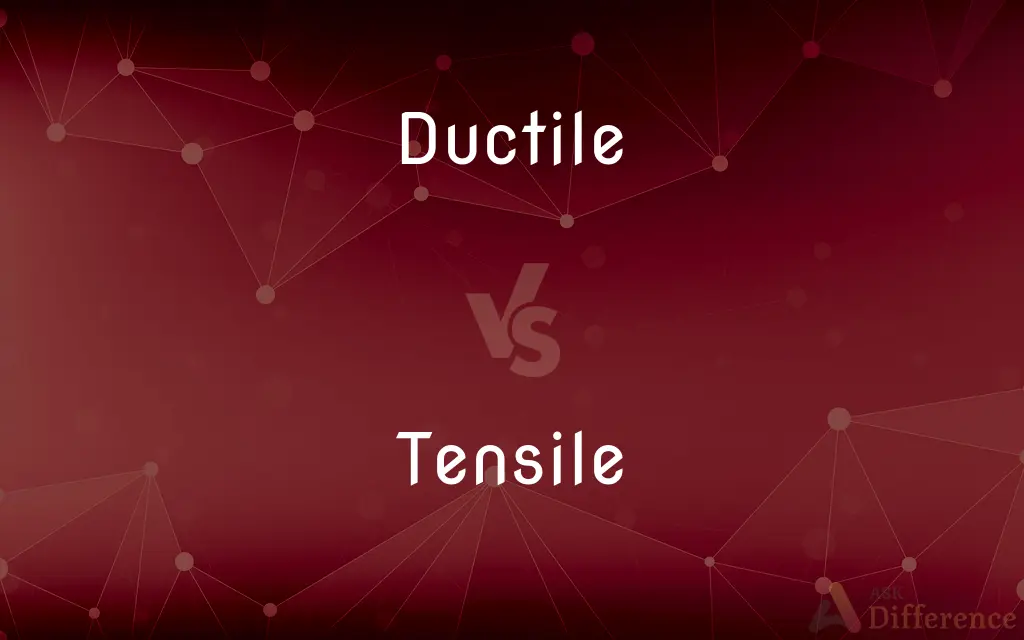Ductile vs. Tensile — What's the Difference?
Edited by Tayyaba Rehman — By Maham Liaqat — Updated on April 5, 2024
Ductility refers to a material's ability to deform under tensile stress; tensile strength measures the maximum stress a material can withstand while being stretched or pulled before breaking.

Difference Between Ductile and Tensile
Table of Contents
ADVERTISEMENT
Key Differences
Ductility is a physical property that describes how easily a material can be stretched or drawn into a wire without breaking, indicating its ability to undergo significant plastic deformation before rupture. Tensile strength, on the other hand, is a measure of the maximum amount of tensile stress a material can bear before failing or breaking, reflecting its resistance to being pulled apart.
Materials that are ductile, such as gold or copper, can undergo considerable elongation when subjected to tensile forces, making them ideal for applications requiring molding or shaping. Materials with high tensile strength, such as steel or carbon fiber, can withstand great forces without breaking, making them suitable for structural applications where mechanical load-bearing is crucial.
Ductility and tensile strength are related but distinct properties; a material can be ductile but have low tensile strength, meaning it can be deformed easily but cannot withstand much force before breaking. Conversely, a material with high tensile strength may not be very ductile, indicating it can resist a lot of stress but will fracture without significant deformation.
Testing for ductility often involves determining the degree to which a material can be stretched into a wire or the amount it can be deformed before fracture. Tensile strength is determined through tensile tests, where a sample is pulled until it breaks, and the maximum stress it withstands is recorded.
Both ductility and tensile strength are crucial in materials science and engineering, determining the selection of materials for various applications. Ductile materials are favored for applications requiring shaping and forming, while materials with high tensile strength are chosen for load-bearing structures and components that must resist pulling forces.
ADVERTISEMENT
Comparison Chart
Definition
Ability to deform under tensile stress
Maximum stress a material can withstand
Key Characteristic
Deformation before breaking
Resistance to breaking under tension
Measurement
Elongation percentage, reduction in area
Maximum stress (MPa or psi)
Typical Materials
Gold, copper, aluminum
Steel, carbon fiber, glass
Applications
Molding, shaping, forming
Structural components, load-bearing parts
Testing
Stretching into wire, deformation testing
Tensile test until failure
Relation to Strength
Indicates deformation ability, not strength
Direct measure of material's load capacity
Compare with Definitions
Ductile
Exhibiting flexibility under tensile loads.
Aluminum’s ductility allows it to be used in aircraft designs.
Tensile
Indicative of a material’s load-bearing capacity.
Carbon fiber's high tensile strength makes it valuable in aerospace.
Ductile
Able to be deformed without losing toughness.
Copper is ductile, making it ideal for wiring.
Tensile
Pertaining to the force needed to stretch a material.
Tensile tests determine the strength of a rope.
Ductile
Characterized by plastic deformation under stress.
Ductile metals can be bent or stretched into thin wires.
Tensile
Relating to tension or being stretched.
Tensile stress is applied in testing the strength of concrete.
Ductile
Material that can undergo significant elongation.
Lead, despite its softness, is quite ductile.
Tensile
Reflecting maximum stress before failure.
Steel rods with high tensile strength are used in construction for their durability.
Ductile
High capacity for deformation before fracture.
The ductility of gold allows it to be hammered into thin sheets.
Tensile
Measuring resistance to breaking under tension.
High tensile strength materials are essential for bridges.
Ductile
Easily drawn into wire or hammered thin
Ductile metals.
Tensile
Relating to tension
A tensile force
Ductile
Easily molded or shaped.
Tensile
Capable of being drawn out or stretched
A tensile steel rod
Ductile
Capable of being readily persuaded or influenced; tractable
A ductile young mind.
Tensile
Of or relating to tension.
Ductile
Capable of being pulled or stretched into thin wire by mechanical force without breaking.
Tensile
Capable of being stretched or extended; ductile.
Ductile
Molded easily into a new form.
Tensile
Of or pertaining to tension.
Ductile
(rare) Led easily; prone to follow.
Tensile
Capable of being stretched; ductile.
Ductile
Easily led; tractable; complying; yielding to motives, persuasion, or instruction; as, a ductile people.
Forms their ductile mindsTo human virtues.
Tensile
Of or pertaining to extension; as, tensile strength.
Ductile
Capable of being elongated or drawn out, as into wire or threads.
Gold . . . is the softest and most ductile of all metals.
Tensile
Capable of extension; ductile; tensible.
Ductile
Easily influenced
Tensile
Of or relating to tension;
Tensile stress
Tensile pull
Ductile
Capable of being shaped or bent or drawn out;
Ductile copper
Malleable metals such as gold
They soaked the leather to made it pliable
Pliant molten glass
Made of highly tensile steel alloy
Tensile
Capable of being shaped or bent or drawn out;
Ductile copper
Malleable metals such as gold
They soaked the leather to made it pliable
Pliant molten glass
Made of highly tensile steel alloy
Common Curiosities
What does a high tensile strength indicate about a material?
High tensile strength indicates that a material can withstand significant stress or load without breaking, important for structural and load-bearing applications.
How is ductility tested?
Ductility is often tested by measuring a material's ability to be stretched into a wire or by the elongation and reduction of area before it breaks under tensile stress.
Can a material be both highly ductile and have high tensile strength?
Yes, some materials, like certain alloys of steel, exhibit both high ductility and tensile strength, making them versatile for various applications.
What role does tensile strength play in engineering?
Tensile strength is vital in engineering for designing structures and components that must withstand forces without failing.
How does temperature affect ductility and tensile strength?
Temperature can significantly affect both properties; typically, increasing temperature increases ductility but may decrease tensile strength.
Why are ductile materials preferred in seismic zones?
Ductile materials can absorb and dissipate energy during seismic events, reducing the risk of catastrophic failure in structures.
Why is ductility important in materials?
Ductility is crucial for materials that need to be shaped, bent, or stretched in manufacturing processes without cracking.
What determines the tensile strength of a material?
The tensile strength is determined by the material's composition, structure, and manufacturing processes, which influence its resistance to stress.
Is ductility the same as flexibility?
While related, ductility specifically refers to a material's ability to deform under tensile stress, while flexibility generally refers to the ability to bend without breaking.
How are ductility and tensile strength considered in material selection?
Material selection for engineering applications considers ductility and tensile strength based on the required performance under operational stresses and deformations.
How do defects affect ductility and tensile strength?
Defects such as cracks, voids, or impurities can significantly reduce both ductility and tensile strength by acting as stress concentrators.
What is the relationship between ductility and toughness?
Ductility and toughness are related but distinct; toughness measures the ability of a material to absorb energy before fracturing, while ductility specifically refers to its ability to deform plastically.
What is the difference between brittle and ductile failure?
Brittle failure occurs with little to no plastic deformation, often suddenly, while ductile failure involves significant deformation, providing more warning.
Can tensile strength be improved?
Tensile strength can be improved through material processing techniques, such as heat treatment, alloying, or cold working.
What is the significance of the yield point in tensile strength?
The yield point marks the stress at which a material begins to deform plastically; beyond this point, the material will not return to its original shape when the load is removed.
Share Your Discovery

Previous Comparison
Disciple vs. Student
Next Comparison
Beaver vs. OtterAuthor Spotlight
Written by
Maham LiaqatEdited by
Tayyaba RehmanTayyaba Rehman is a distinguished writer, currently serving as a primary contributor to askdifference.com. As a researcher in semantics and etymology, Tayyaba's passion for the complexity of languages and their distinctions has found a perfect home on the platform. Tayyaba delves into the intricacies of language, distinguishing between commonly confused words and phrases, thereby providing clarity for readers worldwide.














































